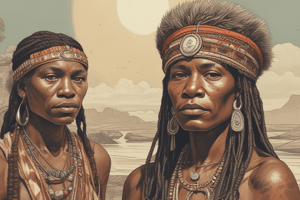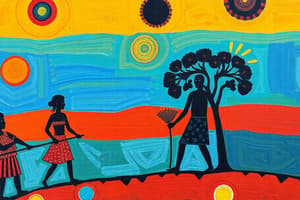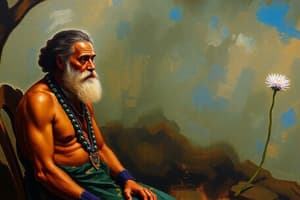Podcast
Questions and Answers
What fundamental belief underpins Indigenous Australians' respect for nature?
What fundamental belief underpins Indigenous Australians' respect for nature?
- The conviction that ancestral spirit-beings created all universal elements. (correct)
- The need to exploit resources for survival.
- The desire to dominate the land and its resources.
- The understanding of scientific classifications of species.
How is the concept of 'Country' defined in the context of traditional Aboriginal and Torres Strait Islander societies?
How is the concept of 'Country' defined in the context of traditional Aboriginal and Torres Strait Islander societies?
- A territory controlled and defended through inter-clan warfare.
- A neutral zone accessible to all clans for resource gathering.
- A piece of land defined by its economic potential, such as mining or agriculture.
- A defined area of land linked to a specific clan, shaping their identity and knowledge. (correct)
What is the primary purpose of 'caring for Country' practices among Indigenous Australians?
What is the primary purpose of 'caring for Country' practices among Indigenous Australians?
- To ensure long-term resource availability and ecological balance. (correct)
- To transform the landscape for agricultural purposes.
- To exploit resources for immediate profit.
- To establish dominance over neighboring clans.
What role did seasonal migration play in the traditional resource management strategies of Indigenous Australians?
What role did seasonal migration play in the traditional resource management strategies of Indigenous Australians?
How did the selection of materials for tools and weapons reflect Indigenous Australians' environmental knowledge?
How did the selection of materials for tools and weapons reflect Indigenous Australians' environmental knowledge?
What is 'firestick farming,' and what ecological benefits does it provide?
What is 'firestick farming,' and what ecological benefits does it provide?
How does the Rainbow Serpent exemplify the cultural significance of water for Indigenous Australians?
How does the Rainbow Serpent exemplify the cultural significance of water for Indigenous Australians?
In what way do the Dreaming stories connect Indigenous Australians to specific landforms?
In what way do the Dreaming stories connect Indigenous Australians to specific landforms?
How does the recognition of Uluru/Ayers Rock as a sacred site reflect Australian government policy?
How does the recognition of Uluru/Ayers Rock as a sacred site reflect Australian government policy?
What evidence suggests that the Great Barrier Reef holds deep historical significance for Aboriginal and Torres Strait Islander peoples?
What evidence suggests that the Great Barrier Reef holds deep historical significance for Aboriginal and Torres Strait Islander peoples?
What is the primary significance of totems, such as marine animals, in Indigenous groups associated with the Great Barrier Reef?
What is the primary significance of totems, such as marine animals, in Indigenous groups associated with the Great Barrier Reef?
How do archaeological findings in the Snowy Mountains support the claim of a long-standing Indigenous connection to the region?
How do archaeological findings in the Snowy Mountains support the claim of a long-standing Indigenous connection to the region?
What does the Ngunnawal word 'Tidbinbilla' signify, and how does it relate to Indigenous cultural practices?
What does the Ngunnawal word 'Tidbinbilla' signify, and how does it relate to Indigenous cultural practices?
Why is understanding the cultural and spiritual values of water important when discussing Indigenous Australians and their environment?
Why is understanding the cultural and spiritual values of water important when discussing Indigenous Australians and their environment?
How did the Torres Strait Islander peoples leverage their marine environment for economic activity?
How did the Torres Strait Islander peoples leverage their marine environment for economic activity?
Which of the following best describes the traditional approach of Indigenous Australians towards natural resource use?
Which of the following best describes the traditional approach of Indigenous Australians towards natural resource use?
What implications might the Indigenous understanding of firestick farming have for modern land management?
What implications might the Indigenous understanding of firestick farming have for modern land management?
How does acknowledging sacred Indigenous sites contribute to environmental conservation efforts in Australia?
How does acknowledging sacred Indigenous sites contribute to environmental conservation efforts in Australia?
What is one example of how traditional Indigenous knowledge informs contemporary practices in Australia?
What is one example of how traditional Indigenous knowledge informs contemporary practices in Australia?
How do clan members acquire knowledge about their Country, including water sources, edible plants, and animal behavior?
How do clan members acquire knowledge about their Country, including water sources, edible plants, and animal behavior?
Flashcards
Indigenous Australians
Indigenous Australians
Aboriginal and Torres Strait Islander peoples of Australia. Their values, identity, spirituality, and lifestyles are influenced by the environment.
Indigenous worldview
Indigenous worldview
The belief that all elements of the universe were created by ancestral spirit beings and are interconnected.
Country
Country
A defined area of land to which a clan is connected; it provides identity and knowledge to its members.
Caring for Country
Caring for Country
Signup and view all the flashcards
Firestick farming
Firestick farming
Signup and view all the flashcards
Value of Water
Value of Water
Signup and view all the flashcards
Dreaming/Dreamtime
Dreaming/Dreamtime
Signup and view all the flashcards
Rainbow Serpent
Rainbow Serpent
Signup and view all the flashcards
Tagai
Tagai
Signup and view all the flashcards
Sacred Sites
Sacred Sites
Signup and view all the flashcards
Uluru/Ayers Rock
Uluru/Ayers Rock
Signup and view all the flashcards
Great Barrier Reef
Great Barrier Reef
Signup and view all the flashcards
Totems
Totems
Signup and view all the flashcards
Snowy Mountains
Snowy Mountains
Signup and view all the flashcards
Stone arrangements
Stone arrangements
Signup and view all the flashcards
Study Notes
- Indigenous Australians, including Aboriginal and Torres Strait Islander peoples, possess a deep connection to the land, waters, and living things
- Their values, identity, spirituality, and lifestyles are heavily influenced by their environment.
- They believe ancestral spirits created all elements of the universe, including humans, plants, animals, landforms, and waterways, as well as the Sun, Moon and stars
- These spirits became part of the landscape after creation, residing in natural features like mountains and rivers.
- Indigenous Australians deeply respect nature due to the environment's essential role in their well-being.
- They feel a responsibility to care for and protect the land and waters.
- They have learned to sustainably use the environment while ensuring resource availability for future generations over tens of thousands of years.
- Methods like firestick farming serve as models for sustainable environmental practices.
Caring for Country
- Traditional societies have defined areas of land, or Country, for each clan.
- Indigenous peoples identify themselves through their specific territory.
- Clans possess unique knowledge about their Country, passed down through generations by elders.
- This knowledge includes finding water sources, identifying edible plants, and understanding seasonal effects on plants and animals.
- "Caring for Country" involves practices for managing land and resources, emphasizing conservation.
- Indigenous groups traditionally stayed in an area for a limited time to prevent over-hunting, fishing, or harvesting.
- They moved to adapt to seasonal changes affecting food availability.
Natural Resources and Their Uses
- Aboriginal and Torres Strait Islander peoples rely/relied on natural resources for everyday needs.
- Plants, animals, and waterways provide food, medicine, shelter, tools, and weapons.
Food
- Traditional peoples were hunters and gatherers.
- Men primarily hunted larger animals, like kangaroos, emus, birds, reptiles, and fish.
- Women and children hunted small animals and gathered fruits, honey, insects, eggs, and plants.
- They only harvested what was needed, avoiding waste.
- Traditional Indigenous food was nutritious and varied based on seasons and location.
Medicine
- Traditional medicines treated ailments like burns, snake bites, jellyfish stings, headaches, and eye infections.
- Treatments, known as "bush" medicine, used ingredients from natural resources.
- Each clan used different medicines based on available plants and animals in their environment and seasons.
- Remedies included wild herbs, tree bark and sap, soil, and animal products.
- Knowledge of plant and product uses, as well as preparation methods, was orally passed down.
Shelter
- Simple shelters were traditionally built using materials available in a clan’s Country.
- Shelter types depended on climate and family size/needs.
- Shelters typically consisted of a branch frame covered with leafy branches or bark.
- More complex, permanent shelters were built in resource-rich areas where families stayed longer, using strong materials like hardwood and woven twine.
Tools and Weapons
- Natural materials were used to make tools and weapons.
- Implements included knives, spears, boomerangs, bowls, and clubs.
- Materials depended on the environment; coastal areas used fishbone for spear tips, while deserts used stone.
- Wooden tools and weapons like spears, boomerangs, and clubs were made from local hardwood trees.
- Wattle trees were commonly used in central Australia, while she-oak was used in southeast Australia.
- Heavier wood was used for hunting large animals in deserts, and lighter materials for duck hunting along coasts.
Firestick Farming
- Aboriginal peoples traditionally used fire to manage the land through firestick farming.
- Controlled burning reduced the risk of destructive bushfires by clearing vegetation.
- It increased food availability and diversity by encouraging plant growth and seed germination.
- Ash served as fertilizer to promote growth, and fresh vegetation attracted huntable animals.
- Thinning vegetation made hunting easier by flushing out animals.
- Burning spinifex grass in desert areas cleared land for edible plants, such as wild tomatoes and bananas.
Cultural and Economic Value of Water
- Water holds cultural, spiritual, and economic value for Indigenous communities.
- Australia's aridity required Aboriginal peoples to develop a deep understanding of water availability and conservation.
- They settled near coasts, rivers, or lakes, such as the Murray River, for resources.
- They caught fish and waterbirds using nets/spears and plants along the river provided food and medicine
- Canoes were built from river red gum bark for fishing and crossing flooded creeks.
- The sea is vitally important to Torres Strait Islander culture.
- They harvested food and traded sea resources, including pearl shells, turtle shells, and feathers.
- Sturdy canoes with outriggers enabled long voyages.
Spiritual Significance of Landforms
- Creation stories explain that spirit beings live on in natural features, which are considered sacred sites.
Uluru/Ayers Rock
- Uluru/Ayers Rock is a giant sandstone rock sacred to the Anangu people.
- The Anangu believe it was created by their ancestors during the Dreaming.
- Its features, like caves and cliffs, are attributed to ancestral activities.
- The Australian government recognized its importance by granting ownership to the Anangu.
- The rock is part of Uluru–Kata Tjuta National Park, a UNESCO World Heritage site.
Great Barrier Reef
- The Great Barrier Reef is a World Heritage site of great importance to Indigenous Australians.
- Over 70 Aboriginal and Torres Strait Islander groups have spiritual/cultural connections to it.
- They are considered traditional owners of the reef.
- Dreaming stories tell of ancestors living on land before sea levels rose, creating islands in the region.
- Marine animals, like sharks and turtles, serve as totems for some groups.
Snowy Mountains
- The Snowy Mountains are traditionally owned by the Ngarigo people, with connections to neighboring groups.
- The mountains hold cultural and spiritual importance, with archaeological and sacred sites.
- Stone arrangements, burial sites, and rock shelters are found throughout the region.
- Birrigai Rock Shelter, meaning "where boys become men," is a significant site for initiation ceremonies.
Studying That Suits You
Use AI to generate personalized quizzes and flashcards to suit your learning preferences.




